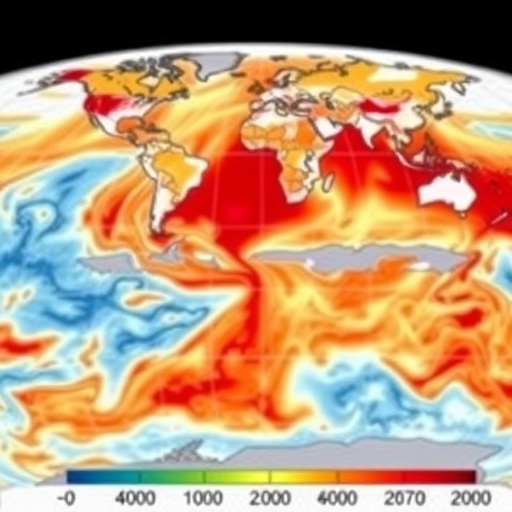University of Miami Researchers Pioneer Accessible Python-Based Global Climate Model, Transforming Education and Research
In a groundbreaking development bridging the gap between advanced climate science and educational accessibility, scientists at the University of Miami have unveiled a novel global atmospheric modeling framework. This innovative platform is crafted entirely in Python, a versatile, high-level programming language, and optimized for use within interactive Jupyter Notebooks. This paradigm shift effectively lowers technical barriers that have historically constrained students and researchers from engaging directly with complex climate modeling, democratizing access to cutting-edge atmospheric science experiments on standard laptops.
Traditionally, global climate models have been entrenched in legacy programming languages such as Fortran, demanding elaborate setups and computational resources that complicate their use, especially for educational purposes. The University of Miami’s new framework dismantles this status quo by combining scientific rigor with user-centric design, allowing seamless execution of sophisticated climate simulations within an intuitive, notebook-driven environment. This interface empowers users to not just run models but also to perform real-time data analysis and generate dynamic visualizations, cultivating an immersive understanding of atmospheric dynamics.
A pivotal advantage of this Python-based system lies in its inherent flexibility and extensibility. Educators can tailor the complexity of classroom exercises to accommodate varying levels of learner expertise, ensuring that both novices and advanced students find the platform approachable and challenging in equal measure. Meanwhile, domain experts and researchers are equipped with the modular architecture necessary for customizing and extending the model to probe original scientific questions related to climate variability and teleconnections, including phenomena such as the El Niño-Southern Oscillation (ENSO).
Dr. Ben Kirtman, Dean of the University of Miami Rosenstiel School of Marine, Atmospheric, and Earth Science and lead study author, highlights the strategic choice of Python due to its clarity and widespread adoption in both academia and industry. “Python’s accessibility was crucial,” Kirtman explains, “because it enables students to focus on the science rather than wrestling with cumbersome code. Moreover, Python’s ecosystem supports sophisticated capabilities like machine learning and artificial intelligence, which are poised to revolutionize climate data analysis in ways legacy models cannot readily match.”
The motivation behind developing a Python-native climate model was born from the firsthand experiences of students grappling with the unintuitive, error-prone codebases of traditional models. Time spent diagnosing and fixing code issues often impeded research progress and hampered experiential learning opportunities. Assistant Professor Marybeth Arcodia, a co-author of the study, recalls these challenges vividly from her time as a graduate student working on long-term climate projections involving complex atmospheric teleconnections. By delivering a more user-friendly platform, the new framework promises to accelerate scientific discovery and training alike.
Notably, the model’s initial validation tests confirmed its fidelity in reproducing global climate patterns linked to El Niño events, underscoring its capacity to resolve large-scale climate interactions and feedbacks with simplified yet physically meaningful parameterizations. This achievement is especially significant given the historic difficulty of balancing model complexity with computational efficiency in educational contexts.
Technical innovations embedded in the framework include adjustable parameterization schemes allowing users to toggle between simplified physical assumptions and more comprehensive atmosphere dynamics. This feature enables both pedagogical scenarios, where illustrative clarity is paramount, and advanced research simulations demanding nuanced realism. Additionally, the platform can ingest real-world forcings such as heterogeneous land surface properties, ocean temperature anomalies, and external heat sources, thereby facilitating studies that integrate atmosphere-ocean coupling and climate forcing mechanisms.
Collaborative efforts with the University of Miami’s Frost Institute for Data Science and Computing were instrumental in managing the large datasets underpinning the model’s development and validation. High-performance data handling ensures that the framework remains responsive and robust even under extensive simulations, which is critical for both classroom demonstrations and research-grade experimentation.
Looking forward, Kirtman envisions launching a transformative experiential climate modeling course tailored for a broad spectrum of students ranging from undergraduates to doctoral candidates. This course will leverage the new tool’s interactivity and transparency, encouraging users to design bespoke climate scenarios and explore hypothesis-driven inquiries, thereby blurring traditional boundaries between education and research in atmospheric sciences.
To maximize global reach and foster collaborative advancement, the University of Miami has released the framework as open-source software on GitHub. This commitment to open accessibility invites educators, students, and climate scientists worldwide to utilize, modify, and enhance the model, potentially accelerating breakthroughs in climate dynamics understanding and response strategies.
The research detailing this initiative, titled “A Simplified-Physics Atmosphere General Circulation Model for Idealized Climate Dynamics Studies,” was published online on August 22, 2025, in the Bulletin of the American Meteorological Society. The study received financial support from prominent agencies including the National Oceanic and Atmospheric Administration (NOAA) and the National Science Foundation (NSF), underscoring the project’s alignment with national priorities in climate research and education.
By blending scientific sophistication with ease of use, this Python-based climate modeling framework stands to revolutionize how global atmospheric dynamics are taught and studied. It empowers the next generation of scientists to experiment with and understand complex climate feedbacks and variability with unprecedented immediacy and insight, marking a significant leap forward in both pedagogy and research infrastructure.
Article Title: A Simplified-Physics Atmosphere General Circulation Model for Idealized Climate Dynamics Studies
News Publication Date: August 22, 2025
Web References:
Keywords: Climate variability, Climate data, Climatology, Climate modeling




